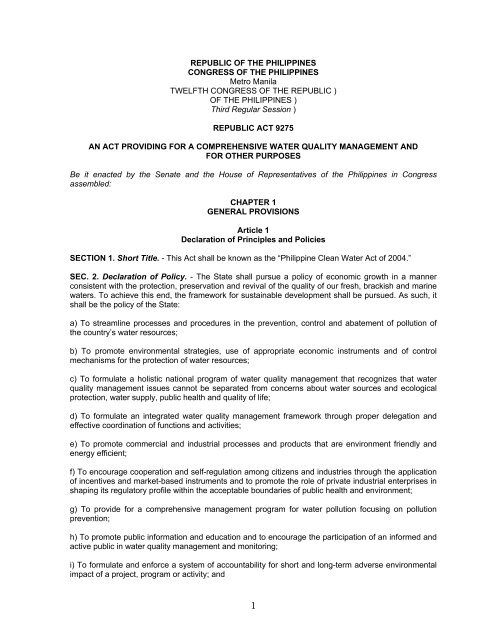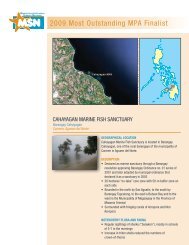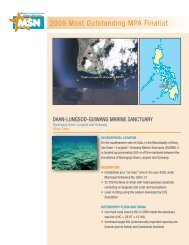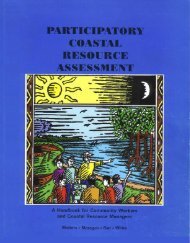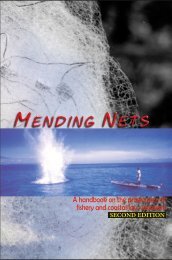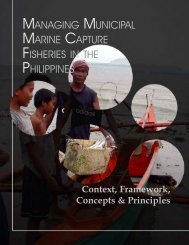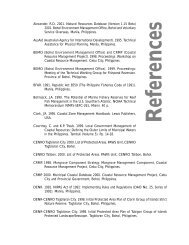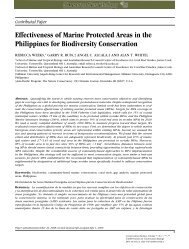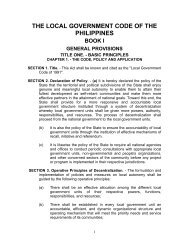Republic Act 9275 - Oneocean.org
Republic Act 9275 - Oneocean.org
Republic Act 9275 - Oneocean.org
Create successful ePaper yourself
Turn your PDF publications into a flip-book with our unique Google optimized e-Paper software.
REPUBLIC OF THE PHILIPPINES<br />
CONGRESS OF THE PHILIPPINES<br />
Metro Manila<br />
TWELFTH CONGRESS OF THE REPUBLIC )<br />
OF THE PHILIPPINES )<br />
Third Regular Session )<br />
REPUBLIC ACT <strong>9275</strong><br />
AN ACT PROVIDING FOR A COMPREHENSIVE WATER QUALITY MANAGEMENT AND<br />
FOR OTHER PURPOSES<br />
Be it enacted by the Senate and the House of Representatives of the Philippines in Congress<br />
assembled:<br />
CHAPTER 1<br />
GENERAL PROVISIONS<br />
Article 1<br />
Declaration of Principles and Policies<br />
SECTION 1. Short Title. - This <strong>Act</strong> shall be known as the “Philippine Clean Water <strong>Act</strong> of 2004.”<br />
SEC. 2. Declaration of Policy. - The State shall pursue a policy of economic growth in a manner<br />
consistent with the protection, preservation and revival of the quality of our fresh, brackish and marine<br />
waters. To achieve this end, the framework for sustainable development shall be pursued. As such, it<br />
shall be the policy of the State:<br />
a) To streamline processes and procedures in the prevention, control and abatement of pollution of<br />
the country’s water resources;<br />
b) To promote environmental strategies, use of appropriate economic instruments and of control<br />
mechanisms for the protection of water resources;<br />
c) To formulate a holistic national program of water quality management that recognizes that water<br />
quality management issues cannot be separated from concerns about water sources and ecological<br />
protection, water supply, public health and quality of life;<br />
d) To formulate an integrated water quality management framework through proper delegation and<br />
effective coordination of functions and activities;<br />
e) To promote commercial and industrial processes and products that are environment friendly and<br />
energy efficient;<br />
f) To encourage cooperation and self-regulation among citizens and industries through the application<br />
of incentives and market-based instruments and to promote the role of private industrial enterprises in<br />
shaping its regulatory profile within the acceptable boundaries of public health and environment;<br />
g) To provide for a comprehensive management program for water pollution focusing on pollution<br />
prevention;<br />
h) To promote public information and education and to encourage the participation of an informed and<br />
active public in water quality management and monitoring;<br />
i) To formulate and enforce a system of accountability for short and long-term adverse environmental<br />
impact of a project, program or activity; and<br />
1
j) To encourage civil society and other sectors, particularly labor, the academe and business<br />
undertaking environment-related activities in their efforts to <strong>org</strong>anize, educate and motivate the people<br />
in addressing pertinent environmental issues and problems at the local and national levels.<br />
SEC. 3. Coverage of the <strong>Act</strong>. – This <strong>Act</strong> shall apply to water quality management in all water bodies:<br />
Provided, That it shall primarily apply to the abatement and control of pollution from land based<br />
sources: Provided, further, That the water quality standards and regulations and the civil liability and<br />
penal provisions under this <strong>Act</strong> shall be enforced irrespective of sources of pollution.<br />
Definition of Terms<br />
Article 2<br />
SEC. 4. Definition of Terms. - As used in this <strong>Act</strong>:<br />
a) Aquifer - means a layer of water-bearing rock located underground that transmits water in sufficient<br />
quantity to supply pumping wells or natural springs.<br />
b) Aquatic life - means all <strong>org</strong>anisms living in freshwater, brackish and marine environments.<br />
c) Beneficial use - means the use of the environment or any element or segment thereof conducive to<br />
public or private welfare, safety and health; and shall include, but not be limited to, the use of water for<br />
domestic, municipal, irrigation, power generation, fisheries, livestock raising, industrial, recreational<br />
and other purposes.<br />
1. Use of water for domestic purposes - means the utilization of water for drinking, washing, bathing,<br />
cooking or other household needs, home gardens and watering of lawns or domestic animals;<br />
2. Use of water for municipal purposes - means the utilization of water for supplying water<br />
requirements of the community;<br />
3. Use of water for irrigation - means the utilization of water for producing agricultural crops;<br />
4. Use of water for power generation - means the utilization of water for producing electrical or<br />
mechanical power;<br />
5. Use of water for fisheries - means the utilization of water for the propagation<br />
of culture of fish as a commercial enterprise;<br />
6. Use of water for livestock raising - means the utilization of water for large<br />
herds or flocks of animals raised as a commercial enterprise;<br />
7. Use of water for industrial purposes - means the utilization of water in factories, industrial plants and<br />
mines, including the use of water as an ingredient of a finished product; and<br />
8. Use of water for recreational purposes - means the utilization of water for<br />
swimming pools, bath houses, boating, water skiing, golf courses and other similar facilities in resorts<br />
and other places of recreation.<br />
d) Classification/Reclassification of Philippine Waters – means the categorization<br />
of all water bodies taking into account, among others, the following:<br />
(1) existing quality of the body of water;<br />
(2) size, depth, surface area covered, volume, direction, rate of flow and gradient of stream;<br />
(3) most beneficial existing and future use of said bodies of water and lands bordering them,<br />
such as for residential, agricultural, aquacultural, commercial, industrial, navigational,<br />
recreational, wildlife conservation and aesthetic purposes; and<br />
(4) vulnerability of surface and groundwater to contamination from pollutive and hazardous<br />
wastes, agricultural chemicals and underground storage tanks<br />
of petroleum products.<br />
e) Civil Society - means non-government <strong>org</strong>anizations (NGOs) and people’s <strong>org</strong>anizations (POs).<br />
f) Cleaner production - means the application of an integrated, preventive environmental strategy to<br />
processes, products, services to increase efficiency and reduce risks to humans and the environment;<br />
g) Clean-up operations - means activities involving the removal of pollutants discharged or spilled into<br />
a water body and its surrounding areas, and the restoration of the affected areas to their former<br />
physical, chemical and biological state or conditions.<br />
2
h) Contamination - means the introduction of substances not found in the natural composition of water<br />
that make the water less desirable or unfit for intended use.<br />
i) Department - means the Department of Environment and Natural Resources.<br />
j) Discharge includes, but is not limited to, the act of spilling, leaking, pumping, pouring, emitting,<br />
emptying, releasing or dumping of any material into a water body oronto land from which it might flow<br />
or drain into said water.<br />
k) Drinking water - means water intended for human consumption or for use in food preparation.<br />
l) Dumping - means any unauthorized or illegal disposal into any body of water or land of wastes or<br />
toxic or hazardous material: Provided, That it does not mean a release of effluent coming from<br />
commercial, industrial, and domestic sources which are within the effluent standards.<br />
m) Effluent - means discharges from known source which is passed into a body of water or land, or<br />
wastewater flowing out of a manufacturing plant, industrial plant including domestic, commercial and<br />
recreational facilities.<br />
n) Effluent standard - means any legal restriction or limitation on quantities, rates, and/or<br />
concentrations or any combination thereof, of physical, chemical or biological parameters of effluent<br />
which a person or point source is allowed to discharge into a body of water or land.<br />
o) Environmental management - means the entire system which includes, but is not limited to,<br />
conservation, regulation and minimization of pollution, clean production, waste management,<br />
environmental law and policy, environmental education and information, study and mitigation of the<br />
environmental impacts of human activity, and environmental research.<br />
p) Environmental management system - means the part of the overall management system that<br />
includes <strong>org</strong>anizational structure, planning activities, responsibilities, practices, procedures, processes<br />
and resources for developing, implementing, achieving, reviewing and maintaining the environmental<br />
policy.<br />
q) Freshwater - means water containing less than 500 ppm dissolved common salt, sodium chloride,<br />
such as that in groundwater, rivers, ponds and lakes.<br />
r) Groundwater - means a subsurface water that occurs beneath a water table in soils and rocks, or in<br />
geological formations.<br />
s) Groundwater vulnerability - means relative ease with which a contaminant located at or near the<br />
land surface can migrate to the aquifer or deep well.<br />
t) Groundwater vulnerability map - means the identified areas of the land surface where groundwater<br />
quality is most at risk from human activities and shall reflect the different degrees of groundwater<br />
vulnerability based on a range of soil properties and hydro-geological criteria to serve as guide in the<br />
protection of the groundwater from contamination.<br />
u) Hazardous waste - means any waste or combination of wastes of solid, liquid, contained gaseous,<br />
or semi-solid form which cause, or contribute to, an increase in mortality or an increase in serious<br />
irreversible, or incapacitating reversible illness, taking into account toxicity of such waste, its<br />
persistence and degradability in nature, its potential for accumulation or concentration in tissue, and<br />
other factors that may otherwise cause or contribute to adverse acute or chronic effects on the health<br />
of persons or <strong>org</strong>anism.<br />
v) Industrial waste - means any solid, semi-solid or liquid waste material with no commercial value<br />
released by a manufacturing or processing plant other than excluded material.<br />
w) Integrated Water Quality Management Framework – means the policy guideline integrating all the<br />
existing frameworks prepared by all government agencies on water quality involving pollution from all<br />
sources. Specifically, the framework shall contain the following:<br />
(a) water quality goals and targets; (b) period of compliance; (c) water pollution control strategies and<br />
techniques; (d) water quality information and education program; (e) human resources development<br />
program.<br />
x) Margin - means a landward and outer limiting edge adjacent to the border of any water bodies or a<br />
limit beyond where saturation zone ceases to exist.<br />
y) National Water Quality Status Report – means a report to be prepared by the Department<br />
indicating: (a) the location of water bodies, their water quality, taking into account seasonal, tidal and<br />
other variations, existing and potential uses and sources of pollution per specific pollutant and<br />
pollution load assessment; (b) water quality management areas pursuant to Section 5 of this <strong>Act</strong>; and<br />
(c) water classification.<br />
3
z) Non-point source - means any source of pollution not identifiable as point source to include, but not<br />
be limited to, runoff from irrigation or rainwater which picks up pollutants from farms and urban areas.<br />
aa) Point source - means any identifiable source of pollution with specific point of discharge into a<br />
particular water body.<br />
bb) Pollutant - shall refer to any substance, whether solid, liquid, gaseous or radioactive, which<br />
directly or indirectly:<br />
(i) alters the quality of any segment of the receiving water body so as to affect or tend to affect<br />
adversely any beneficial use thereof;<br />
(ii) is hazardous or potentially hazardous to health;<br />
(iii) imparts objectionable odor, temperature change, or physical, chemical or biological change to any<br />
segment of the water body; or<br />
(iv) is in excess of the allowable limits or concentrations or quality standards specified, or in<br />
contravention of the condition, limitation or restriction prescribed in this <strong>Act</strong>.<br />
cc) Pollution control technology - means pollution control devices or apparatus, processes, or<br />
other means that effectively prevent, control or reduce pollution of water caused by effluents and other<br />
discharges, from any point source at levels within the water pollution standards.<br />
dd) Potentially infectious medical waste - includes isolation wastes, infectious agents, human<br />
blood and blood products, pathological wastes, sharps, body parts, contaminated bedding, surgical<br />
wastes, and other disposable medical equipment and material that may pose a risk to the public<br />
health, welfare or the marine environment.<br />
ee) Secretary - means the Secretary of the Department of Environment and Natural<br />
Resources (DENR).<br />
ff) Septage - means the sludge produced on individual onsite waste water disposal systems,<br />
principally septic tanks and cesspools.<br />
gg) Sewage - means water-borne human or animal wastes, excluding oil or oil wastes,<br />
removed from residences, buildings, institutions, industrial and commercial establishments together<br />
with such groundwater, surface water and storm water as maybe present including such waste from<br />
vessels, offshore structures, other receptacles intended to receive or retain wastes, or other places or<br />
the combination thereof.<br />
hh) Sewerage - includes, but is not limited to, any system or network of pipelines, ditches,<br />
channels, or conduits including pumping stations, lift stations and force mains, service connections<br />
including other constructions, devices, and appliances appurtenant thereto, which involves the<br />
collection, transport, pumping and treatment of sewage to a point of disposal.<br />
ii) Sludge - means any solid, semi-solid or liquid waste or residue generated from a<br />
wastewater treatment plant, water supply treatment plant, or water control pollution facility, or any<br />
other such waste having similar characteristics and effects.<br />
jj) Surface water - means all water which is open to the atmosphere and subject to surface<br />
runoff.<br />
kk) Treatment - means any method, technique, or process designed to alter the physical,<br />
chemical or biological and radiological character or composition of any waste or wastewater to reduce<br />
or prevent pollution.<br />
ll) Toxic amount - means the lowest amount of concentration of toxic pollutants which may<br />
cause chronic or long-term acute or lethal conditions or effects to the aquatic life or health of persons<br />
or which may adversely affect designated water uses.<br />
mm) Waste - means any material either solid, liquid, semisolid, contained gas or other forms<br />
resulting from industrial, commercial, mining or agricultural operations, or from community and<br />
household activities that is devoid of usage and discarded.<br />
nn) Wastewater - means waste in liquid state containing pollutants.<br />
oo) Water body - means both natural and man-made bodies of fresh, brackish, and saline<br />
waters, and includes, but is not limited to, aquifers, groundwater, springs, creeks, streams, rivers,<br />
ponds, lagoons, water reservoirs, lakes, bays, estuarine, coastal and marine waters. Water bodies do<br />
not refer to those constructed, developed and used purposely as water treatment facilities and/or<br />
water storage for recycling and re-use which are integral to process industry or manufacturing.<br />
pp) Water pollution - means any alteration of the physical, chemical or biological or<br />
radiological properties of a water body resulting in the impairment of its purity or quality.<br />
4
qq) Water quality - means the characteristics of water which define its use in terms of physical,<br />
chemical, biological, bacteriological or radiological characteristics by which the acceptability of water is<br />
evaluated.<br />
rr) Water quality guidelines - means the level for a water constituent or numerical values of<br />
physical, chemical, biological and bacteriological or radiological parameters which are used to classify<br />
water resources and their use, which does not result in significant health risk and which are not<br />
intended for direct enforcement but only for water quality management purposes, such as determining<br />
time trends, evaluating stages of deterioration or enhancement of the water quality, and as basis for<br />
taking positive action in preventing, controlling or abating water pollution.<br />
ss) Water Quality Management Area <strong>Act</strong>ion Plan - includes, but not be limited to, the following:<br />
(a) goals and targets including sewerage or septage program; (b) schedule of compliance to<br />
meet the applicable requirements of this <strong>Act</strong>; (c) water pollution control strategies or techniques; (d)<br />
water quality information and education program; (e) resource requirement and possible sources; (f)<br />
enforcement procedures of the plan; and (g) rewards and incentives under Chapter 4 of this <strong>Act</strong>.<br />
CHAPTER 2<br />
WATER QUALITY MANAGEMENT SYSTEM<br />
Article 1<br />
General Provisions<br />
SEC. 5. Water Quality Management Area. - The Department, in coordination with National Water<br />
Resources Board (NWRB), shall designate certain areas as water quality management areas using<br />
appropriate physiographic units such as watershed, river basins or water resources regions. Said<br />
management areas shall have similar hydrological, hydrogeological, meteorological or geographic<br />
conditions which affect the physicochemical, biological and bacteriological reactions and diffusions of<br />
pollutants in the water bodies, or otherwise share common interest or face similar development<br />
programs, prospects, or problems. Said management area shall be governed by a governing board<br />
composed of representatives of mayors and governors of member local government units (LGUs), and<br />
representatives of relevant national government agencies, duly registered nongovernmental<br />
<strong>org</strong>anization, water utility sector, and business sector. The Department representative shall chair the<br />
governing board. In the case of the LGUs with memberships on more than one (1) management<br />
board, the LGU shall designate only one (1) single representative for all the management areas where<br />
it is a member. The governing board shall formulate strategies to coordinate policies necessary for the<br />
effective implementation of this <strong>Act</strong> in accordance with those established in the framework and monitor<br />
the compliance with the action plan. Each management area shall create a multi-sectoral group to<br />
establish and effect water quality surveillance and monitoring network including sampling schedules<br />
and other similar activities. The group shall submit its report and recommendation to the chairman of<br />
the governing board.<br />
A technical secretariat for each management area is hereby created which shall be part of the<br />
Department and shall provide technical support to the governing board. They shall be composed of at<br />
least four (4) members who shall have the following minimum qualifications:<br />
a) One (1) member shall be a member of the Philippine Bar;<br />
b) One (1) member shall be a Chemical Engineer, Chemist, Sanitary Engineer, Environmental<br />
Engineer or Ecologist or have significant training and experience in chemistry;<br />
c) One (1) member shall be a Civil Engineer or Hydrologist or have significant training and experience<br />
in closely related fields and mainly experience on ground water, respectively; and<br />
d) One (1) member shall be a Geologist or Biologist or have significant training<br />
5
and experience in closely related fields.<br />
The areas within the jurisdiction of the Laguna Lake Development Authority (LLDA) shall be<br />
designated as one management area under the administration of LLDA in accordance with <strong>Republic</strong><br />
<strong>Act</strong> No. 4850, as amended: Provided, however, That the standards promulgated pursuant to this <strong>Act</strong><br />
and wastewater charge system established pursuant hereof shall be enforced in said area.<br />
SEC. 6. Management of Non-attainment Areas. - The Department shall designate water bodies, or<br />
portions thereof, where specific pollutants from either natural or man-made source have already<br />
exceeded water quality guidelines as non-attainment areas for the exceeded pollutants. It shall<br />
prepare and implement a program that will not allow new sources of exceeded water pollutant in nonattainment<br />
areas without a corresponding reduction in discharges from existing sources: Provided,<br />
That if the pollutant is naturally occurring, e.g. naturally high boron and other elements in geothermal<br />
areas, discharge of such pollutant may be allowed: Provided, further, That the effluent concentration of<br />
discharge shall not exceed the naturally occurring level of such pollutant in the area: Provided, finally,<br />
That the effluent concentration and volume of discharge shall not adversely affect water supply, public<br />
health and ecological protection. The Department shall, in coordination with NWRB, Department of<br />
Health (DOH), Department of Agriculture (DA), governing board and other concerned government<br />
agencies and private sectors shall take such measures as may be necessary to upgrade the quality of<br />
such water in non-attainment areas to meet the standards under which it has been classified.<br />
Upgrading of water quality shall likewise include undertakings which shall improve the water quality of<br />
a water body to a classification that will meet its projected or potential use. The LGUs shall prepare<br />
and implement contingency plans and other measures including relocation, whenever necessary, for<br />
the protection of health and welfare of the residents within potentially affected areas.<br />
SEC. 7. National Sewerage and Septage Management Program. - The Department of Public Works<br />
and Highways (DPWH), through its relevant attached agencies, in coordination with the Department,<br />
LGUs and other concerned agencies, shall, as soon as possible, but in no case exceeding a period of<br />
twelve (12) months from the effectivity of this <strong>Act</strong>, prepare a national program on sewerage and<br />
septage management in connection with Section 8 hereof. Such program shall include a priority listing<br />
of sewerage, septage and combined sewerage-septage projects for LGUs based on population<br />
density and growth, degradation of water resources, topography, geology, vegetation,<br />
programs/projects for the rehabilitation of existing facilities and such other factors that the Secretary<br />
may deem relevant to the protection of water quality. On the basis of such national listing, the national<br />
government may allot, on an annual basis, funds for the construction and rehabilitation of required<br />
facilities.<br />
Each LGU shall appropriate the necessary land, including the required rights-ofway/ road access to<br />
the land for the construction of the sewage and/or septage treatment facilities. Each LGU may raise<br />
funds to subsidize necessary expenses for the operation and maintenance of sewerage treatment or<br />
septage facility servicing their area of jurisdiction through local property taxes and enforcement of a<br />
service fee system.<br />
SEC. 8. Domestic Sewage Collection, Treatment and Disposal. - Within five (5) years following the<br />
effectivity of this <strong>Act</strong>, the agency vested to provide water supply and sewerage facilities and/or<br />
concessionaires in Metro Manila and other highly urbanized cities (HUCs) as defined in <strong>Republic</strong> <strong>Act</strong><br />
No. 7160, in coordination with LGUs, shall be required to connect the existing sewage line found in all<br />
subdivisions, condominiums, commercial centers, hotels, sports and recreational facilities, hospitals,<br />
market places, public buildings, industrial complex and other similar establishments including<br />
households to available sewerage system: Provided, That the said connection shall be subject to<br />
sewerage services charge/fees in accordance with existing laws, rules or regulations unless the<br />
sources had already utilized their own sewerage system: Provided, further, That all sources of sewage<br />
and septage shall comply with the requirements herein. In areas not considered as HUCs, the DPWH<br />
in coordination with the Department, DOH and other concerned agencies, shall employ septage or<br />
combined sewerage-septage management system.<br />
6
For the purpose of this section, the DOH, in coordination with other government agencies, shall<br />
formulate guidelines and standards for the collection, treatment and disposal of sewage including<br />
guidelines for the establishment and operation of centralized sewage treatment system.<br />
SEC. 9. National Water Quality Management Fund. - A water quality management fund, to be<br />
administered by the Department, in coordination with other concerned agencies, as a special account<br />
in the National Treasury is hereby established. The fund shall be used to finance the following:<br />
a) Finance containment and clean-up operations of the government in water pollution cases;<br />
b) Guarantee restoration of ecosystems and rehabilitation of affected areas;<br />
c) Support research, enforcement and monitoring activities;<br />
d) Provide technical assistance to the implementing agencies;<br />
e) Grant rewards and incentives;<br />
f) Support information and educational campaign; and<br />
g) Such other disbursements made solely for the prevention, control or abatement<br />
of water pollution and management and administration of the management areas<br />
in the amounts authorized by the Department.<br />
The fines imposed and damages awarded to the government by the Pollution Adjudication Board<br />
(PAB), proceeds of permits issued by the Department under this <strong>Act</strong>, donations, endowments and<br />
grants in the form of contributions to the national government under this <strong>Act</strong> shall form part of the fund.<br />
Such donations, endowments and grants shall be exempt from donor’s taxes and all other taxes,<br />
charges or fees imposed by the government and shall be deductible from the gross income of the<br />
donor for income tax purposes.<br />
Disbursements from the fund shall be subject to the usual accounting and budgeting rules and<br />
regulations.<br />
SEC. 10. The Area Water Quality Management Fund. - The area water quality management fund is<br />
hereby established for the maintenance and upkeep of the water bodies in a water quality<br />
management area. The fund shall be utilized for the grant of rewards and incentives for entities whose<br />
effluent discharges are better than the water quality criteria of the target classification of the receiving<br />
body of water, loans for acquisitions and repairs of facilities to reduce quantity and improve quality of<br />
wastewater discharges, and regular maintenance of the water bodies within the management area.<br />
An amount of not more than ten percent (10%) of the total amount accruing to the funds annually shall<br />
be allocated for the operational expenses of the governing board, its secretariat and multi-sectoral<br />
water quality surveillance and monitoring network. This fund shall initially be sourced from the fines<br />
incurred by the establishments located in rural areas before the effectivity of this <strong>Act</strong>. Thereafter, the<br />
fees collected under the wastewater charge system established under Section 13 of this <strong>Act</strong>,<br />
donations, endowments and grants for water quality management of the area shall accrue to the fund.<br />
Disbursements from the fund shall be subject to the usual accounting and budgeting rules and<br />
regulations. This fund shall be managed by the Board of the corresponding management area.<br />
SEC. 11. Water Quality Variance for Geothermal and Oil and Gas Exploration.<br />
- The Department may provide variance in water quality criteria and standards for geothermal<br />
exploration that encounters reinjection constraints: Provided, That there shall be provision for<br />
adequate protection of beneficial use of water bodies downstream of the geothermal project: Provided,<br />
further, That this provision may be applied to oil and gas exploration as determined by the<br />
Department.<br />
SEC. 12. Categories of Industry Sector. – Within twenty-four (24) months from the effectivity of this<br />
<strong>Act</strong>, and every two (2) years thereafter, the Department shall, through due public consultation, revise<br />
and publish a list of categories of industry sector for which effluent standards will be provided for each<br />
significant wastewater parameter per industry sector.<br />
7
The Department shall provide additional classification based on other parameters specifically<br />
associated to discharge of a particular industry which shall be included in the listing of categories<br />
prescribed in the preceding paragraph.<br />
Article 2<br />
Water Pollution Permits and Charges<br />
SEC. 13. Wastewater Charge System. – The Department shall implement a wastewater charge<br />
system in all management areas including the Laguna Lake Region and Regional Industrial Centers<br />
through the collection of wastewater charges/fees. The system shall be established on the basis of<br />
payment to the government for discharging wastewater into the water bodies. Wastewater charges<br />
shall be established taking into consideration the following:<br />
(a) To provide strong economic inducement for polluters to modify their production or management<br />
processes or to invest in pollution control technology in order to reduce the amount of water pollutants<br />
generated;<br />
(b) To cover the cost of administering water quality management or improvement programs;<br />
(c) Reflect damages caused by water pollution on the surrounding environment, including the cost of<br />
rehabilitation;<br />
(d) Type of pollutant;<br />
(e) Classification of the receiving water body; and<br />
(f) Other special attributes of the water body.<br />
The fee shall be based on the net waste load depending on the wastewater charge formula which<br />
shall be established with due public consultation within six (6) months from the effectivity of this <strong>Act</strong>:<br />
Provided, That net waste load shall refer to the difference of the initial waste load of the abstracted<br />
water and the waste load of the final effluent discharge of an industry: Provided, further, That no net<br />
waste load shall be lower than the initial waste load: Provided, finally, That wastewater charge system<br />
shall not apply to wastewater from geothermal exploration. Industries whose water effluent are within<br />
standards promulgated pursuant to this <strong>Act</strong>, shall only be charged with minimal reasonable amount<br />
which shall be determined by the Department after due public consultation, giving account to<br />
volumetric rate of discharge and the effluent concentration.<br />
SEC. 14. Discharge Permits. – The Department shall require owners or operators of facilities that<br />
discharge regulated effluents pursuant to this <strong>Act</strong> to secure a permit to discharge. The discharge<br />
permit shall be the legal authorization granted by the Department to discharge wastewater: Provided,<br />
That the discharge permit shall specify among others, the quantity and quality of effluent that said<br />
facilities are allowed to discharge into a particular water body, compliance schedule and monitoring<br />
requirement. As part of the permitting procedure, the Department shall encourage the adoption of<br />
waste minimization and waste treatment technologies when such technologies are deemed cost<br />
effective. The Department shall also develop procedures to relate the current water quality guideline or<br />
the projected water quality guideline of the receiving water body/ies with total pollution loadings from<br />
various sources, so that effluent quotas can be properly allocated in the discharge permits. For<br />
industries without any discharge permit, they may be give n a period of twelve (12) months after the<br />
effectivity of the implementing rules and regulations promulgated pursuant to this <strong>Act</strong>, to secure a<br />
discharge permit. Effluent trading may be allowed per management area.<br />
Article 3<br />
Financial liability mechanism<br />
SEC. 15. Financial Liability for Environmental Rehabilitation. - The Department shall require<br />
program and project proponents to put up environmental guarantee fund (EGF) as part of the<br />
environmental management plan attached to the environmental compliance certificate pursuant to<br />
Presidential Decree No. 1586 and its implementing rules and regulations. The EGF shall finance the<br />
maintenance of the health of the ecosystems and specially the conservation of watersheds and<br />
aquifers affected by the development, and the needs of emergency response, clean-up or<br />
8
ehabilitation of areas that may be damaged during the program’s or project’s actual implementation.<br />
Liability for damages shall continue even after the termination of a program or project and, until the<br />
lapse of a given period indicated in the environmental compliance certificate, as determined by the<br />
Department. The EGF may be in the form of a trust fund, environmental insurance, surety bonds,<br />
letters of credit, self-insurance and any other instruments which may be identified by the Department.<br />
The choice of the guarantee instrument or combinations thereof shall depend, among others, on the<br />
assessment of the risks involved and financial test mechanisms devised by the Department.<br />
Proponents required to put up guarantee instruments shall furnish the Department with evidence of<br />
availment of such instruments from accredited financial instrument providers.<br />
SEC. 16. Clean-Up Operations. - Notwithstanding the provisions of Sections 15 and 26 hereof, any<br />
person who causes pollution in or pollutes water bodies in excess of the applicable and prevailing<br />
standards shall be responsible to contain, remove and clean-up any pollution incident at his own<br />
expense to the extent that the same water bodies have been rendered unfit for utilization and<br />
beneficial use: Provided, That in the event emergency clean-up operations are necessary and the<br />
polluter fails to immediately undertake the same, the Department, in coordination with other<br />
government agencies concerned, shall conduct containment, removal and clean-up operations.<br />
Expenses incurred in said operations shall be reimbursed by the persons found to have caused such<br />
pollution upon proper administrative determination in accordance with this <strong>Act</strong>. Reimbursements of the<br />
cost incurred shall be made to the Water Quality Management Fund or to such other funds where said<br />
disbursements were sourced.<br />
SEC. 17. Programmatic Environmental Impact Assessment. – The Department shall implement<br />
programmatic compliance with the environmental impact assessment system, as in the following types<br />
of development:<br />
(a) development consisting of a series of similar projects, or a project subdivided into several phases<br />
and/or stages whether situated in a contiguous area or geographically dispersed; and<br />
(b) development consisting of several components or a cluster of projects colocated in an area such<br />
as an industrial estate, an export processing zone, or a development zone identified in a local land<br />
use plan. Programmatic compliance with the environmental impact assessment system shall be<br />
guided by carrying capacity assessments determined from ecological profiles. Ecological profiles<br />
shall identify environmental constraints and opportunities in programmatic areas. Programmatic<br />
assessment shall also take into account cumulative impacts and risks.<br />
Consistent with the provisions of the Local Government Code, the Department may enter into<br />
agreement with LGUs to incorporate programmatic environmental impact assessment into the<br />
preparation, updating or revision of local land use plans and area development plans.<br />
SEC. 18. Environmental Impact Assessment System Programmatic Compliance<br />
with Water Quality Standards. – The Department may allow each regional industrial center<br />
established pursuant to <strong>Republic</strong> <strong>Act</strong> No. 7916 (PEZA law) to allocate effluent quotas to pollution<br />
sources within its jurisdiction that qualify under an environmental impact assessment system<br />
programmatic compliance program in accordance with Presidential Decree No. 1586 and its<br />
implementing rules and regulations.<br />
CHAPTER 3<br />
INSTITUTIONAL MECHANISM<br />
SEC. 19. Lead Agency. - The Department shall be the primary government agency responsible for<br />
the implementation and enforcement of this <strong>Act</strong> unless otherwise provided herein. As such, it shall<br />
have the following functions, powers and responsibilities:<br />
a) Prepare a National Water Quality Status Report within twenty-four (24) months from the effectivity<br />
of this <strong>Act</strong>: Provided, That the Department shall thereafter review or revise and publish annually, or as<br />
the need arises, said report;<br />
9
) Prepare an Integrated Water Quality Management Framework within twelve (12) months following<br />
the completion of the status report;<br />
c) Prepare a ten (10) - year Water Quality Management Area <strong>Act</strong>ion Plan within twelve (12) months<br />
following the completion of the framework for each designated water management area. Such action<br />
plan shall be reviewed by the water quality management area governing board every five (5) years or<br />
as the need arises;<br />
d) Prepare and publish a national groundwater vulnerability map incorporating the prevailing standards<br />
and methodologies, within twenty four (24) months after the effectivity of this <strong>Act</strong>;<br />
e) Enforce, review and revise within twelve (12) months from the effectivity of this <strong>Act</strong> water quality<br />
guidelines after due consultation with the concerned stakeholder sectors: Provided, That the<br />
Department, in coordination with appropriate agencies shall review said guidelines every five (5) years<br />
or as need arises;<br />
f) Review and set effluent standards every five (5) years from the effectivity of this <strong>Act</strong> or sooner as<br />
determined by the Department: Provided, That in the interim, the provisions of DENR Administrative<br />
Order No. 35 of the Department shall apply: Provided, further, That when new and more stringent<br />
standards are set in accordance with this section, the Department may establish a grace period with a<br />
maximum of five (5) years: Provided, finally, That such grace period shall be limited to the moratorium<br />
on the issuance of cease and desist and/or closure order against the industry’s operations except in<br />
the event such operation poses serious and grave threat to the environment, or the industry fails to<br />
institute retooling, upgrading or establishing an environmental management system (EMS). g)<br />
Establish within twelve (12) months from the effectivity of this <strong>Act</strong>, internationally- accepted procedures<br />
for sampling and analysis of pollutants and in coordination with other concerned agencies, formulate<br />
testing procedures and establish an accreditation system for laboratories;<br />
h) Within eighteen (18) months from the effectivity of this <strong>Act</strong> and every two (2) years thereafter,<br />
categorize point and non-point sources of water pollution;<br />
i) Classify groundwater sources within twelve (12) months from the effectivity of this <strong>Act</strong>;<br />
j) Classify or reclassify all water bodies according to their beneficial usages:<br />
Provided, That in the interim, the provisions of DENR Administrative Order No. 34 shall apply:<br />
Provided, further, That such classification or reclassification shall take into consideration the operation<br />
of businesses or facilities that are existing prior to the effectivity of the <strong>Act</strong>: Provided, furthermore, That<br />
the Department may authorize the use of the water for other purposes that are more restrictive in<br />
classification: Provided, finally, That discharges resulting from such use shall meet the effluent<br />
standards set by the Department;<br />
k) Exercise jurisdiction over all aspects of water pollution, determine its location, magnitude, extent,<br />
severity, causes, effects and other pertinent information on pollution, and to take measures, using<br />
available methods and technologies to prevent and abate such pollution;<br />
l) Exercise supervision and control over all aspects of water quality management;<br />
m) Establish a cooperative effort in partnership with the government, LGUs, academic institutions, civil<br />
society and the private sector to attain the objectives of this <strong>Act</strong>;<br />
n) Disseminate information and conduct educational awareness and value formation programs and<br />
campaigns on the effects of water pollution on health and environment, water quality management,<br />
and resource conservation and recovery to encourage an environmentally action-oriented society in<br />
coordination with government agencies identified in Section 22 (f);<br />
o) Promote and encourage private and business sectors especially manufacturing and processing<br />
plants the use of water quality management systems equipment, including but not limited to, industrial<br />
wastewater treatment collection and treatment facilities;<br />
p) Report, on an annual basis, to Congress the quality status of water bodies and other pertinent<br />
information and recommend possible legislation, policies and programs for environmental<br />
management and water pollution control;<br />
q) Issue rules and regulations for the effective implementation of the provisions of this <strong>Act</strong>;<br />
r) Issue orders against any person or entity and impose fines, penalties and other administrative<br />
sanctions to compel compliance with water quality regulations and the provisions of this <strong>Act</strong>;<br />
s) Undertake appropriate protocol with other concerned agencies for immediate coordinated<br />
responses to water related emergency incidents;<br />
t) Issue permits, clearances and similar instruments pursuant to this <strong>Act</strong>; and<br />
10
u) Exercise such powers and perform such other functions as may be necessary to carry out the<br />
objectives of this <strong>Act</strong>.<br />
The Department shall gradually devolve to the LGUs, and to the governing boards the authority to<br />
administer some aspects of water quality management and regulation, including, but not to be limited<br />
to, permit issuance, monitoring and imposition of administrative penalties, when, upon the<br />
Department’s determination, the LGU or the governing board has demonstrated readiness and<br />
technical capability to undertake such functions.<br />
SEC. 20. Role of Local Government Units (LGUs). - LGUs shall share the responsibility in the<br />
management and improvement of water quality within their territorial jurisdictions. Each LGU shall<br />
within six (6) months after the establishment of the water quality management area action plan<br />
prepare a compliance scheme in accordance thereof, subject to review and approval of the governing<br />
board.<br />
Each LGU shall, through its Environment and Natural Resources Office (ENRO) established in<br />
<strong>Republic</strong> <strong>Act</strong> No. 7160, have the following powers and functions:<br />
a) Monitoring of water quality;<br />
b) Emergency response;<br />
c) Compliance with the framework of the Water Quality Management <strong>Act</strong>ion Plan;<br />
d) To take active participation in all efforts concerning water quality protection and rehabilitation; and<br />
e) To coordinate with other government agencies and civil society and the concerned sectors in the<br />
implementation of measures to prevent and control water pollution:<br />
Provided, however, That in provinces/cities/municipalities where there are no environment and natural<br />
resources officers, the local executive concerned may, with the approval of the Secretary of the DENR<br />
designate any of his official and/or chief of office preferably the provincial, city or municipal<br />
agriculturist, or any of his employee: Provided, finally, That in case an employee is designated as<br />
such, he must have sufficient experience in environmental and natural resources management,<br />
conservation and utilization.<br />
SEC. 21. Business and Industry Role in Environmental Management. – The Department and the<br />
LGUs, in coordination with the appropriate government agencies, and in consultation with the<br />
business and industrial sectors including chambers of commerce, shall formulate appropriate<br />
incentives for the adoption of procedures that will preserve and protect our water bodies through the<br />
introduction of innovative equipment and processes that reduce if not totally eliminate the discharge of<br />
pollutants into our water bodies.<br />
SEC. 22. Linkage Mechanism. - The Department and its concerned attached agencies including<br />
LLDA shall coordinate and enter into agreement with other government agencies, industrial sector and<br />
other concerned sectors in the furtherance of the objectives of this <strong>Act</strong>. The following agencies shall<br />
perform the functions specified hereunder:<br />
(a) Philippine Coast Guard in coordination with the DA and the Department shall enforce for the<br />
enforcement of water quality standards in marine waters, set pursuant to this <strong>Act</strong>, specifically from<br />
offshore sources;<br />
(b) DPWH through its attached agencies, such as the MWSS, LWUA, and including other urban water<br />
utilities for the provision of sewerage and sanitation facilities and the efficient and safe collection,<br />
treatment and disposal of sewage within their area of jurisdiction;<br />
(c) DA, shall coordinate with the Department, in the formulation of guidelines for the re-use of<br />
wastewater for irrigation and other agricultural uses and for the prevention, control and abatement of<br />
pollution from agricultural and aquaculture activities: Provided, That discharges coming from non-point<br />
sources be categorized and further defined pursuant to this <strong>Act</strong>: Provided, further, That the Bureau of<br />
Fisheries and Aquatic Resources (BFAR) of the DA shall be primarily responsible for the prevention<br />
and control of water pollution for the development, management and conservation of the fisheries and<br />
aquatic resources;<br />
11
(d) DOH shall be primarily responsible for the promulgation, revision and enforcement of drinking<br />
water quality standards;<br />
(e) DOST, in coordination with the Department and other concerned agencies, shall prepare a<br />
program for the evaluation, verification, development and public dissemination of pollution prevention<br />
and cleaner production technologies; and<br />
(f) Department of Education (DepEd), Commission on Higher Education (CHED),Department of the<br />
Interior and Local Government (DILG) and Philippine Information Agency (PIA) shall assist and<br />
coordinate with the Department in the preparation and implementation of a comprehensive and<br />
continuing public education and information program pursuant to the objectives of this <strong>Act</strong>.<br />
SEC. 23. Requirement of Record-keeping, Authority for Entry to Premises<br />
and Access to Documents. – The Department or its duly authorized representative shall, after proper<br />
consultation and notice, require any person who owns or operates any pollution source or who is<br />
subject to any requirement of this <strong>Act</strong> to submit reports and other written information as may be<br />
required by the Department.<br />
Any record, report or information obtained under this section shall be made available to the public,<br />
except upon a satisfactory showing to the Department by the entity concerned that the record, report,<br />
or information or parts thereof, if made public, would divulge secret methods or processes entitled to<br />
protection as intellectual property. Such record, report or information shall likewise be incorporated in<br />
the Department’s industrial rating system. Pursuant to this <strong>Act</strong>, the Department, through its authorized<br />
representatives, shall have the right to: (a) enter any premises or to have access to documents and<br />
relevant materials as referred to in the herein preceding paragraph; (b) inspect any pollution or waste<br />
source, control device, monitoring equipment or method required; and (c) test any discharge. In cases<br />
of fish kill incidence, the Bureau of Fisheries of the DA, in the course of its investigation, may enter the<br />
premises of an establishment reported to have caused said incident.<br />
SEC. 24. Pollution Research and Development Programs. – The Department, in coordination with<br />
the Department of Science and Technology (DOST), and other concerned agencies and academic<br />
research institutions, shall establish a national research and development program for the prevention<br />
and control of water pollution. As part of said program, the DOST shall conduct and promote the<br />
coordination and acceleration of research, investigation, experiments, training, surveys and studies<br />
relating to the causes, extent, prevention and control of pollution among concerned government<br />
agencies and research institutions.<br />
CHAPTER 4<br />
INCENTIVES AND REWARDS<br />
SEC. 25. Rewards. - Rewards, monetary or otherwise, shall be provided to individuals, private<br />
<strong>org</strong>anization and entities, including civil society, that have undertaken outstanding and innovative<br />
projects, technologies, processes and techniques or activities in water quality management. Said<br />
rewards shall be sourced from the Water Quality Management Fund herein created.<br />
SEC. 26. Incentives Scheme. - An incentive scheme is hereby provided for the purpose of<br />
encouraging LGUs, water districts (WDs), enterprises, or private entities, and individuals, to develop or<br />
undertake an effective water quality management, or actively participate in any program geared<br />
towards the promotion thereof as provided in this <strong>Act</strong>.<br />
A. Non-fiscal Incentive<br />
1. Inclusion in the Investments Priority Plan (IPP). – Subject to the rules and regulations of the Board<br />
of Investments (BOI), industrial wastewater treatment and/or adoption of water pollution control<br />
technology, cleaner production and waste minimization technology shall be classified as preferred<br />
areas of investment under its annual priority plan and shall enjoy the applicable fiscal and non-fiscal<br />
incentives as may be provided for under the Omnibus Investment Code, as amended.<br />
12
Fiscal Incentives<br />
1. Tax and Duty Exemption on Imported Capital Equipment - Within ten (10) years upon the effectivity<br />
of this <strong>Act</strong>, LGUs, WDs, enterprises or private entities shall enjoy tax-and-duty-free importation of<br />
machinery, equipment and spare parts used for industrial wastewater treatment/collection and<br />
treatment facilities: Provided, That the importation of such machinery, equipment and spare parts shall<br />
comply with the following conditions:<br />
a) They are not manufactured domestically in sufficient quantity, of comparable quality and at<br />
reasonable prices;<br />
b) They are reasonably needed and will be used actually, directly and exclusively for the above<br />
mentioned activities; and<br />
c) Written endorsement by the Department that the importation of such machinery, equipment and<br />
spare parts would be beneficial to environmental protection and management: Provided, further, That<br />
the sale, transfer or disposition of such machinery, equipment and spare parts without prior approval<br />
of the BOI within five (5) years from the date of acquisition shall be prohibited, otherwise the LGU<br />
concerned, WD, enterprise or private entity and the concerned vendee, transferee or assignee shall be<br />
solidarily liable to pay twice the amount of tax and duty exemption given it.<br />
2. Tax Credit on Domestic Capital Equipment - Within ten (10) years from the effectivity of this <strong>Act</strong>, a<br />
tax credit equivalent to one hundred percent (100%) of the value of the national internal revenue taxes<br />
and customs duties that would have been waived on the machinery, equipment, and spare parts, had<br />
these items been imported shall be given to enterprises or private entities and individuals, subject to<br />
the same conditions and prohibition cited in the preceding paragraph.<br />
3. Tax and Duty Exemption of Donations, Legacies and Gifts - All legacies, gifts and donations to<br />
LGUs, WDs, enterprises, or private entities and individuals, for the support and maintenance of the<br />
program for effective water quality management shall be exempt from donor’s tax and shall be<br />
deductible from the gross income of the donor for income tax purposes. Imported articles donated to,<br />
or for the account of any LGUs, WDs, local water utilities, enterprises, or private entities and<br />
individuals to be exclusively used for water quality management programs shall be exempted from the<br />
payment of customs duties and applicable internal revenue taxes. Industrial wastewater treatment<br />
and/or installation of water pollution control devices shall be classified as pioneer and preferred areas<br />
of investment under the BOI’s annual priority plan and shall enjoy the applicable fiscal and non-fiscal<br />
incentives as may be provided for under the Omnibus Investment Code, as amended.<br />
B. Financial Assistance Program<br />
Government financial institutions such as the Development Bank of the Philippines, Land Bank of the<br />
Philippines, Government Service Insurance System, and such other government institutions providing<br />
financial services shall, in accordance with and to the extent allowed by the enabling provisions of their<br />
respective charters or applicable laws, accord high priority to extend financial services to LGUs, WDs,<br />
enterprises, or private entities engaged in sewage collection and treatment facilities.<br />
C. Extension of Grants to LGUs<br />
Cities and municipalities which shall establish or operate sewerage facilities may be entitled to receive<br />
grants for the purpose of developing technical capabilities.<br />
CHAPTER 5<br />
CIVIL LIABILITY/PENAL PROVISIONS<br />
SEC. 27. Prohibited <strong>Act</strong>s. - The following acts are hereby prohibited:<br />
a) Discharging, depositing or causing to be deposited material of any kind directly or indirectly into the<br />
water bodies or along the margins of any surface water, where, the same shall be liable to be washed<br />
into such surface water, either by tide action or by storm, floods or otherwise, which could cause water<br />
pollution or impede natural flow in the water body;<br />
b) Discharging, injecting or allowing to seep into the soil or sub-soil any substance in any form that<br />
would pollute groundwater. In the case of geothermal projects,<br />
13
and subject to the approval of the Department, regulated discharge for short-term activities (e.g. well<br />
testing, flushing, commissioning, venting) and deep re-injection of geothermal liquids may be allowed:<br />
Provided, That safety measures are adopted to prevent the contamination of the groundwater;<br />
c) Operating facilities that discharge regulated water pollutants without the valid<br />
required permits or after the permit was revoked for any violation of any condition therein;<br />
d) Disposal of potentially infectious medical waste into sea water by vessels unless the health or<br />
safety of individuals on board the vessel is threatened by a great and imminent peril;<br />
e) Unauthorized transport or dumping into sea waters of sewage sludge or solid waste as defined<br />
under <strong>Republic</strong> <strong>Act</strong> No. 9003;<br />
f) Transport, dumping or discharge of prohibited chemicals, substances or pollutants listed under<br />
<strong>Republic</strong> <strong>Act</strong> No. 6969;<br />
g) Operate facilities that discharge or allow to seep, willfully or through gross negligence, prohibited<br />
chemicals, substances or pollutants listed under R. A. No. 6969, into water bodies or wherein the<br />
same shall be liable to be washed into such surface, ground, coastal, and marine water;<br />
h) Undertaking activities or development and expansion of projects, or operating wastewater/<br />
sewerage facilities in violation of Presidential Decree No. 1586 and its implementing rules and<br />
regulations;<br />
i) Discharging regulated water pollutants without the valid required discharge permit pursuant to this<br />
<strong>Act</strong> or after the permit was revoked for any violation of any condition therein;<br />
j) Noncompliance of the LGU with the Water Quality Framework and Management Area <strong>Act</strong>ion Plan.<br />
In such a case, sanctions shall be imposed on the local government officials concerned;<br />
k) Refusal to allow entry, inspection and monitoring by the Department in accordance with this <strong>Act</strong>;<br />
l) Refusal to allow access by the Department to relevant reports and records in accordance with this<br />
<strong>Act</strong>;<br />
m) Refusal or failure to submit reports whenever required by the Department in accordance with this<br />
<strong>Act</strong>;<br />
n) Refusal or failure to designate pollution control officers whenever required by the Department in<br />
accordance with this <strong>Act</strong>; and<br />
o) Directly using booster pumps in the distribution system or tampering with the water supply in such a<br />
way as to alter or impair the water quality.<br />
SEC. 28. Fines, Damages and Penalties. - Unless otherwise provided herein, any person who<br />
commits any of the prohibited acts provided in the immediately preceding section or violates any of the<br />
provision of this <strong>Act</strong> or its implementing rules and regulations, shall be fined by the Secretary, upon the<br />
recommendation of the PAB in the amount of not less than Ten thousand pesos (P10,000.00) nor<br />
more than Two hundred thousand pesos (P200,000.00) for every day of violation. The fines herein<br />
prescribed shall be increased by ten percent (10%) every two (2) years to compensate for inflation and<br />
to maintain the deterrent function of such fines: Provided, That the Secretary, upon recommendation<br />
of the PAB may order the closure, suspension of development or construction, or cessation of<br />
operations or, where appropriate disconnection of water supply, until such time that proper<br />
environmental safeguards are put in place and/or compliance with this <strong>Act</strong> or its rules and regulations<br />
are undertaken. This paragraph shall be without prejudice to the issuance of an ex parte order for<br />
such closure, suspension of development or construction, or cessation of operations during the<br />
pendency of the case.<br />
Failure to undertake clean-up operations, willfully, or through gross negligence, shall be punished by<br />
imprisonment of not less than two (2) years and not more than four (4) years and a fine not less than<br />
Fifty thousand pesos (P50,000.00) and not more than One hundred thousand pesos (P100,000.00)<br />
per day for each day of violation. Such failure or refusal which results in serious injury or loss of life<br />
and/or irreversible water contamination of surface, ground, coastal and marine water shall be punished<br />
with imprisonment of not less than six (6) years and one (1) day and not more than twelve (12) years,<br />
and a fine of Five hundred thousand pesos (P500,000.00) per day for each day during which the<br />
omission and/or contamination continues.<br />
In case of gross violation of this <strong>Act</strong>, the PAB shall issue a resolution recommending that the proper<br />
government agencies file criminal charges against the violators.<br />
14
Gross violation shall mean any of the following:<br />
(a) deliberate discharge of toxic pollutants identified pursuant to <strong>Republic</strong> <strong>Act</strong> No. 6969 in toxic<br />
amounts;<br />
(b) five (5) or more violations within a period of two (2) years; or<br />
(c) blatant disregard of the orders of the PAB, such as the non-payment of fines,<br />
breaking of seals or operating despite the existence of an order for closure, discontinuance or<br />
cessation of operation. In which case, offenders shall be punished with a fine of not less than Five<br />
hundred thousand pesos (P500,000.00) but not more than Three million pesos (P3,000,000.00) per<br />
day for each day of violation or imprisonment of not less than six (6) years but not more than ten (10)<br />
years, or both, at the discretion of the court. If the offender is a juridical person, the president,<br />
manager and the pollution control officer or the official in charge of the operation shall suffer the<br />
penalty herein provided. For violations falling under Section 4 of Presidential Decree No. 979 or any<br />
regulations prescribed in pursuance thereof, such person shall be liable for a fine of not less than Fifty<br />
thousand pesos (P50,000.00) nor more than One million pesos (P1,000,000.00) or by imprisonment<br />
of not less than one (1) year nor more than six (6) years or both, for each offense, without prejudice to<br />
the civil liability of the offender in accordance with existing laws. If the offender is a juridical entity, then<br />
its officers, directors, agents or any person primarily responsible shall be held liable: Provided, That<br />
any vessel from which oil or other harmful substances are discharged in violation of Section 4 of<br />
Presidential Decree No. 979 shall be liable for penalty of fine specified in the immediately preceding<br />
paragraph and clearance of such vessel from the port of the Philippines may be withheld until the fine<br />
is paid and such penalty shall constitute a lien on such vessel which may be recovered in proceedings<br />
by libel in rem in the proper court which the vessel may be. The owner or operator of a vessel or<br />
facility which discharged the oil or other harmful substances will be liable to pay for any clean-up<br />
costs.<br />
Provided, finally, That water pollution cases involving acts or omissions committed within the Laguna<br />
Lake Region shall be dealt with in accordance with the procedure under <strong>Republic</strong> <strong>Act</strong> No. 4850 as<br />
amended.<br />
SEC. 29. Administrative Sanctions Against Non-compliance with the Water Quality<br />
Management Area <strong>Act</strong>ion Plan. - Local government officials concerned shall be subject to<br />
administrative sanctions in case of failure to comply with their action plan in accordance with the<br />
relevant provisions of <strong>Republic</strong> <strong>Act</strong> No. 7160.<br />
CHAPTER 6<br />
ACTIONS<br />
SEC. 30. Administrative <strong>Act</strong>ion. - Without prejudice to the right of any affected person to file an<br />
administrative action, the Department shall, on its own instance or upon verified complaint by any<br />
person, institute administrative proceedings in the proper forum against any person who violates:<br />
a) Standards or limitations provided by this <strong>Act</strong>; or<br />
b) By any such order, rule or regulation issued by the Department with respect to such standard or<br />
limitation.<br />
CHAPTER 7<br />
FINAL PROVISIONS<br />
SEC. 31. Appropriations. - An amount of One hundred million pesos (P100,000,000.00) shall be<br />
appropriated from the savings of the National Government to the Department for the initial<br />
implementation of this <strong>Act</strong>. Thereafter, the amount necessary to effectively carry out the provisions of<br />
15
this <strong>Act</strong> shall be included in the General Appropriations <strong>Act</strong> of the year following its enactment into law<br />
and thereafter.<br />
SEC. 32. Implementing Rules and Regulations. - The Department, in coordination with the<br />
Committees on Environment and Ecology of the Senate and the House of Representatives,<br />
respectively and other concerned agencies, shall promulgate the implementing rules and regulations<br />
for this <strong>Act</strong>, within one (1) year after the enactment of this <strong>Act</strong>: Provided, That rules and regulations<br />
issued by other government agencies and instrumentalities for the prevention and/or abatement of<br />
water pollution not inconsistent with this <strong>Act</strong> shall supplement the rules and regulations issued by the<br />
Department, pursuant to the provisions of this <strong>Act</strong>. The draft of the implementing rules and regulations<br />
shall be published and be the subject of public consultations with affected sectors. There shall be a<br />
mandatory review of the implementing rules and regulations and standards set pursuant to the<br />
provisions of this <strong>Act</strong>.<br />
SEC. 33. Joint Congressional Oversight Committee. - There is hereby created a Joint<br />
Congressional Oversight Committee to monitor the implementation of the <strong>Act</strong> and to review the<br />
implementing rules and regulations promulgated by the Department.<br />
The Committee shall be composed of five (5) Senators and five (5) Representatives to be appointed<br />
by the Senate President and the Speaker of the House of Representatives, respectively. The<br />
Oversight Committee shall be co-chaired by the Chairpersons of the Committee on Environment of the<br />
Senate and the Committee on Ecology of the House of Representatives.<br />
SEC. 34. Repealing Clause. - Presidential Decree No. 984 is hereby repealed. <strong>Republic</strong> <strong>Act</strong> Nos.<br />
6969 and 4850 as amended, Presidential Decree Nos. 1586, 1152, 979 and 856 are hereby amended<br />
and modified accordingly. All other laws, orders, issuance, rules and regulations inconsistent herewith<br />
are hereby repealed or modified accordingly.<br />
SEC. 35. Separability Clause. - If any provision of this <strong>Act</strong> or the application of such provision to any<br />
person or circumstances is declared unconstitutional, the remainder of the <strong>Act</strong> or the application of<br />
such provision to other person or circumstances shall not be affected by such declaration.<br />
SEC. 36. Effectivity. - This <strong>Act</strong> shall take effect fifteen (15) days from the date of its publication in the<br />
Official Gazette or in at least two (2) newspapers of general circulation.<br />
Approved,<br />
Sgd. JOSE DE VENECIA JR.<br />
Speaker of the House<br />
of Representative<br />
Sgd. FRANKING DRILON<br />
President of the Senate<br />
This <strong>Act</strong> which is a consolidation of Senate Bill No. 2115 and House Bill No. 5398 was finally passed<br />
by the Senate and the House of Representatives on February 4, 2004.<br />
Sgd. ROBERTO P. NAZARENO<br />
Secretary General<br />
House of Representatives<br />
Sgd. OSCAR G. YABES<br />
Secretary of Senate<br />
Approved: March 2, 2004<br />
Sgd. GLORIA MACAPAGAL ARROYO<br />
President of the Philippines<br />
16


